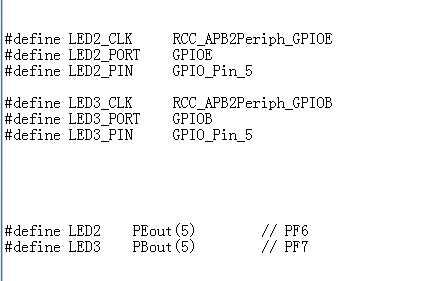标签:
这个LED的小程序基于的是德飞莱的最小系统板 我当时写这个程序的时候想的就是这个程序能够便于理解 也便于移植 便于调用 我参加过电赛 对于STM32的一个管脚修改的麻烦是深有体会 一个地方不对就没法工作 所以这次我写这个库的时候 我也特别注意了这些方面 一个小LED 挺简单的 有时候用来做调试用的话 我觉得还是挺好的 下面我将自己的源码分享 个人能力有限 大神不要笑哈!!!
在这个源码里面 你仅仅只需要修改

的内容 就可以快速的对STM32的任意一个管脚实行 高低电平控制的
注意就是里面有个delay的操作 这个事先要在主函数里面进行初始化的(如果不初始化会死在循环里面) 这个delay的源码是借用原子大哥的
#ifndef __LED_H #define __LED_H #include<sys.h> #define LED2_ON 1 #define LED2_OFF 2 #define LED3_ON 3 #define LED3_OFF 4 #define LED2_REV 5 //管脚取反 #define LED3_REV 6 //管脚取反 #define LED2_CLK RCC_APB2Periph_GPIOE #define LED2_PORT GPIOE #define LED2_PIN GPIO_Pin_5 #define LED3_CLK RCC_APB2Periph_GPIOB #define LED3_PORT GPIOB #define LED3_PIN GPIO_Pin_5 #define LED2 PEout(5) // PF6 #define LED3 PBout(5) // PF7 void LED_Init(void); void LED2_Init(void); void LED3_Init(void); void DEBUG_LED(u8 x); #endif
/****************************************************************************** * 文件 LED.c * 作者 Belye * 版本 ST V3.5.0 * 日期 03-February-2016 * 提要 基于德飞莱开发板的LED的底层驱动程序 * 使用方式 函数调用示例 * 注意 记得修改对应的LED初始化管脚 ******************************************************************************/ //V1.0 修改说明 //调整代码 加入取反 /*************************************** 函数调用示例 ************************************ LED2_Init();//记得修改此函数里面的内容 DEBUG_LED(LED2_ON); **********************************************************************************************/ #include<LED.h> #include<delay.h> void LED_Init() { LED2_Init(); LED3_Init(); } void LED2_OPEN() { LED2=0; } void LED2_CLOSE() { LED2=1; } void LED2REV() { GPIO_WriteBit(LED2_PORT, LED2_PIN,(BitAction)(1-(GPIO_ReadOutputDataBit(LED2_PORT, LED2_PIN)))); } void LED3_OPEN() { LED3=0; } void LED3_CLOSE() { LED3=1; } void LED3REV() { GPIO_WriteBit(LED3_PORT, LED3_PIN,(BitAction)(1-(GPIO_ReadOutputDataBit(LED3_PORT, LED3_PIN)))); } void DEBUG_LED(u8 x) { switch (x) { case 1: LED2_OPEN(); break; case 2: LED2_CLOSE(); break; case 3: LED3_OPEN(); break; case 4: LED3_CLOSE(); break; case 5: LED2REV(); break; case 6: LED3REV(); break; default: break; } } void LED2_Init(void) { GPIO_InitTypeDef GPIO_InitStructure; RCC_APB2PeriphClockCmd(LED2_CLK, ENABLE); GPIO_InitStructure.GPIO_Pin = LED2_PIN; GPIO_InitStructure.GPIO_Mode = GPIO_Mode_Out_PP; GPIO_InitStructure.GPIO_Speed = GPIO_Speed_50MHz; GPIO_Init(LED2_PORT, &GPIO_InitStructure); GPIO_SetBits(LED2_PORT,LED2_PIN); } void LED3_Init(void) { GPIO_InitTypeDef GPIO_InitStructure; RCC_APB2PeriphClockCmd(LED3_CLK, ENABLE); GPIO_InitStructure.GPIO_Pin = LED3_PIN; GPIO_InitStructure.GPIO_Mode = GPIO_Mode_Out_PP; GPIO_InitStructure.GPIO_Speed = GPIO_Speed_50MHz; GPIO_Init(LED3_PORT, &GPIO_InitStructure); GPIO_SetBits(LED3_PORT,LED3_PIN); }
标签:
原文地址:http://www.cnblogs.com/Belye/p/5185804.html